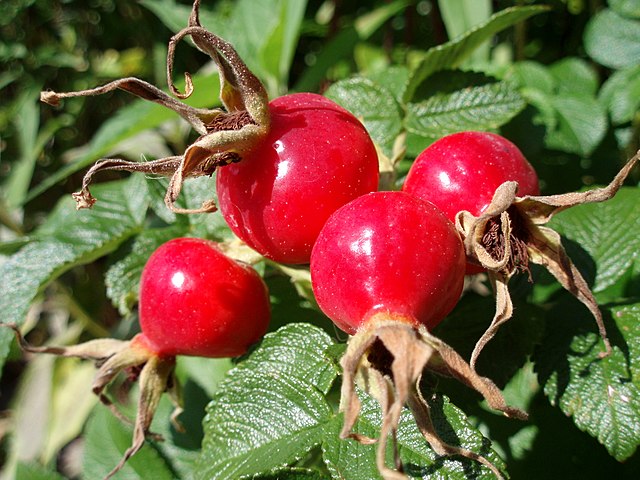Loading AI tools
Fruit of the rose plant From Wikipedia, the free encyclopedia
The rose hip or rosehip, also called rose haw and rose hep, is the accessory fruit of the various species of rose plant. It is typically red to orange, but ranges from dark purple to black in some species. Rose hips begin to form after pollination of flowers in spring or early summer, and ripen in late summer through autumn.



Roses are propagated from rose hips by removing the achenes that contain the seeds from the hypanthium (the outer coating) and sowing just beneath the surface of the soil. The seeds can take many months to germinate. Most species require chilling (stratification), with some such as Rosa canina only germinating after two winter chill periods.

Rose hips are used in bread and pies, jam, jelly, marmalade, syrup, soup, tea, wine, and other beverages.
Rose hips can be eaten raw, like berries, if care is taken to avoid the hairs inside the fruit. These urticating hairs are used as itching powder.[1]
A few rose species are sometimes grown for the ornamental value of their hips, such as Rosa moyesii, which has prominent, large, red bottle-shaped fruits. Rosa macrophylla 'Master Hugh' has the largest hips of any readily available rose.[2]
Rose hips are commonly used in herbal tea, often blended with hibiscus. An oil is also extracted from the seeds. Rose hip soup, known as nyponsoppa in Swedish, is especially popular in Sweden. Rhodomel, a type of mead, is made with rose hips.
Rose hips can be used to make pálinka, the traditional Hungarian fruit brandy popular in Hungary, Romania, and other countries sharing Austro-Hungarian history. Rose hips are also the central ingredient of cockta, the fruity-tasting national soft drink of Slovenia.
Dried rose hips are also sold for crafts and home fragrance purposes. The Inupiat mix rose hips with wild redcurrant and highbush cranberries and boil them into a syrup.[3]

Wild rose hip fruits are particularly rich in vitamin C, containing 426 mg per 100 g[4] or 0.4% by weight (w/w). RP-HPLC assays of fresh rose hips and several commercially available products revealed a wide range of L-ascorbic acid (vitamin C) content, ranging from 0.03 to 1.3%.[5]
Rose hips contain the carotenoids beta-carotene, lutein, zeaxanthin, and lycopene.[6][7] A meta-analysis of human studies examining the potential for rose hip extracts to reduce arthritis pain concluded there was a small effect requiring further analysis of safety and efficacy in clinical trials.[8] Use of rose hips is not considered an effective treatment for knee osteoarthritis.[9]
Seamless Wikipedia browsing. On steroids.
Every time you click a link to Wikipedia, Wiktionary or Wikiquote in your browser's search results, it will show the modern Wikiwand interface.
Wikiwand extension is a five stars, simple, with minimum permission required to keep your browsing private, safe and transparent.